A Gentle Introduction to a Rare, but Often Benign Disease: Sarcoidosis
A few weeks ago, a Steemit friend wrote that her daughter had recently been diagnosed with sarcoidosis. My vague understanding of this disease was that it somehow involved the lungs. After reading a bit, I learned that besides the lungs, other organs may be affected. Also, though sarcoidosis was first described more than a hundred years ago, many questions remain: What is the cause? Who is affected? How best to treat it? Even, what are the symptoms? There are partial answers to each of these questions, but satisfactory, complete explanations are lacking.
In the midst of all the unanswered questions, one piece of reassuring information stands out: 75% of people who are diagnosed with sarcoidosis never seek follow-up treatment. This statistic is offered by the American Journal of Respiratory and Critical Care Medicine.


Jonathan Hutchinson (1828-1913)

Image Credit: Sir Leslie Ward ("Spy") in Vanity Fair, 1890. Public domain.

Jonathan Hutchinson is credited with being the first physician to
describe sarcoidosis. At the time--1869--sarcoidosis was considered a
dermatological disease. Hutchinson noted "the formation of multiple,
raised, dusky-red patches" on his patient's skin. The patches, he
observed, did not tend to become inflamed, nor did they tend to
ulcerate. Also, these patches occurred in groups, and extended
"slowly". Hutchinson named the disease after one of his patient's, Mrs. Mortimer.
Not until 1900 was sarcoidosis recognized as a systemic disorder. It was then that the term 'sarkoid' was first used to describe the disease. The doctor credited with this insight was Caesar Boeck, of Norway.
It's interesting that Dr. Boeck was Norwegian, because today we understand that people of Scandinavian descent seem to have an elevated risk of developing sarcoidosis.

Although It's Rare, Beagles Can Get Sarcoidosis, Also

Image Credit: User Groppe, used under CC 3.0 license
While these two beagles, Nini and Jule, appear to be well, I found one case where an 11-year old beagle was successfully treated for cutaneous sarcoidosis. Apparently, sarcoidosis, while rare, does occur in dogs.

What is Sarcoidosis? What Do We Understand Today?

There are some things we know about sarcoidosis for certain. It is a disease of inflammation. The "dusky-red patches" referred to by Hutchinson have a name now: granulomas. Granulomas are described by the Mayo Clinic as "small areas of inflammation". The Clinic explains that these patches, or small lumps, may be formed by the body as a defense against infection or injury. Tissue surrounds a foreign body. This process is called 'foreign body encapsulation', and it is the mechanism at work in granuloma formation.

Ultrasound Image Showing Silicone Granuloma in a Breast
Image credit: Nevit Dilman (talk). Used under a CC 3.0 license.
The caption under this image reads: "Ultrasound images of breast with silicone granuloma. Snow like echogenicity with posterior shadowing"

Granulomas are not unique to sarcoidosis and may be found in other diseases. The problem with granulomas is that their presence in tissue, over time, may cause damage. However, they may also be of no consequence. People often discover granulomas incidentally, during a scan for an unrelated complaint.
In sarcoidosis, as Caesar Boeck explained, granulomas may appear anywhere in the body. The most common sites are the lungs, the skin, the eyes, and lymph nodes in the thoracic cavity.

Thoracic Cavity
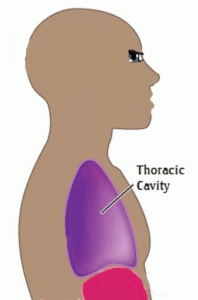
Image credit: Adapted from Open Stax, used under a CC 3.0 license. Eyeball courtesy of Mentor Eye.png: White Cat, public domain
I adapted the diagram to make it look less clinical. That model may even be winking at us :)

Who is Likely to be Diagnosed with Sarcoidosis?

This is a question with an evolving answer. One of the most recent articles I read, in the Journal of Biomedical Science (June, 2019 ) explains that the demographics of the disease suggest both environment and genetics play a role.
According to the Journal article, women, overall, have a higher incidence of sarcoidosis. Also, Northern Europeans and African Americans have a relatively high incidence of disease (it's still rare). However, people of African descent who live in the Caribbean do not show an elevated incidence. Asians--specifically, people who live in Taiwan and Japan--have a relatively low incidence.
If this sounds puzzling, yes it is. And it's complicated by the fact that different areas of the world may have different diagnostic criteria.

Diagnosing Sarcoidosis

PET/CT Scan
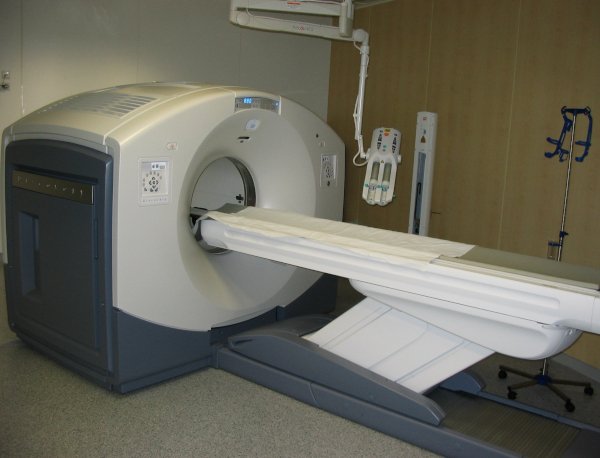
Image credit: Hg699, public domain.
The machine shown in the picture combines the ability of a PET scan and a CT scan. According to an article in the Journal of Clinical Imaging Science, this machine can be useful (for people who have serious lung involvement) not only for diagnosing sarcoidosis, but also for monitoring its progress.

Diagnosing sarcoidosis is a challenge, because symptoms may resemble
those of other diseases. Two blood tests that can offer some guidance
are: ACE (Angiotensin Converting Enzyme) and sIL-2R (soluble interleukin 2 receptor.)
Elevated levels on either test suggest the possibility of sarcoidosis,
but the results are not conclusive. Other clinic evidence (symptoms)
must be present, and more tests must be conducted.
A 2019 article, published in PLOS/ONE, reports that if a patient is suspected of having sarcoidosis, and that patient does not
have elevated levels of sIL-2R, then the diagnosis of sarcoidosis can
be ruled out. The study on which this article is based indicates that
the sIL-2R test is more sensitive than the ACE in diagnosing the
disease. So, if there's a strong suspicion of sarcoidosis, and
symptoms are troubling, testing for sIL-2R might be something a patient
could ask for. I think I would.

Other tests used to diagnose sarcoidosis--in cases where treatment may be necessary--include performing biopsies of suspected tissue. One of the most recent developments in this area is a procedure called Transbronchial Lung Cryobiopsy. This is for people who have suspected lung disease. According to a November 2019 article in Sarcoidosis News, the new procedure "safely and successfully helps to provide a definitive sarcoidosis diagnosis when the usual and less-invasive diagnostic tools are insufficient."

What Causes It?

The most recent research points to a combination of factors--pathogens, environmental exposure, and genetics.
Pathogens
Cutibacterium Acne
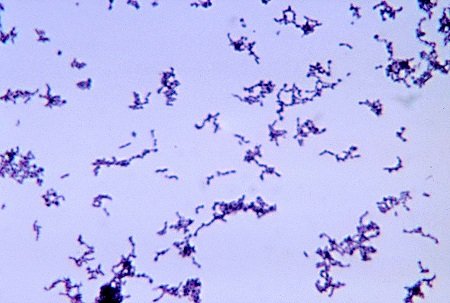
Image Credit: Bobby Strong, of the CDC. Public domain

Pathogens associated with development of sarcoidosis include Candida, Cutibacterium acne and Mycobacterium tuberculosis. Candida causes candidiasis, Cutibacterium acne is implicated in common acne, and Mycobacterium tuberculosis causes tuberculosis.
It is also suggested that exposure to mycobacterial antigens, may lead to development of disease. The exposure may be through natural infection, or through tuberculosis (BCG) vaccine.

Apparatus Used for Giving BCG Vaccine
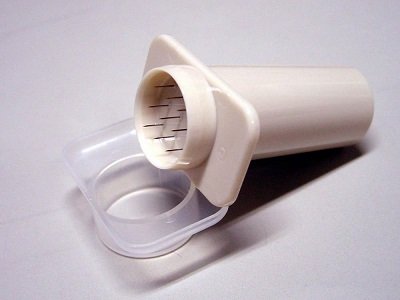
Image credit: Y tambe GFDL and CC-by-SA 2.5, 2.0, 1.0

Environmental Exposure

Image: Staffsfire, CC 4.0 license
There seems to be general agreement that environmental exposures may trigger sarcoidosis in genetically susceptible individuals. Not all the studies agree on the extent of this influence. However, it has been shown that people who work in certain industries have a higher incidence of disease. And, in one specific case, people who worked at the World Trade Center after the 9/11 attack, have an elevated incidence of sarcoidosis.
As for tying sarcoidosis to specific substances: a number of studies have shown a correlation between occupational exposure to the following materials and development of the disease:
Silica
Women at Work in a War Production Plant, WW I (1914-1918)

Image and citation credit: First World War Womens War Work Collection Public domain
The picture shows a worker cutting fused silica basins for use in
lavatories in a factory of Thermal Syndicate Limited at
Wallsend-on-Tyne, July 1918.

The association between silica exposure and sarcoidosis has been the
subject of much research over the years. Silica is not only implicated
in the development of sarcoidosis, but has also been linked to other inflammatory diseases, including systemic lupus, rheumatoid arthritis and silicosis, a debilitating lung disease.

Pallets of Silica in a Warehouse
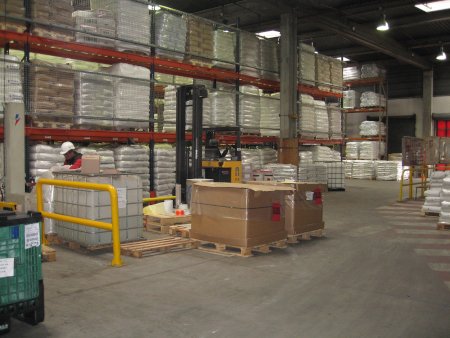
Image credit: Cjp24, CC 1.0,2.0,2.5,3.0 license

Silica is ubiquitous
in the environment. It is used in an amazingly wide variety of
products. Industrial exposure may occur in many different industries.
Some of the products in which it may be found: paint, pharmaceuticals,
plastic, food, cement, potting soil, plastic board, various construction
material, and cat litter (if it contains silica.) This list of substances was derived from the Journal of Exposure Analysis and Environmental Epidemiology

Ciprofloxocin (Cipro Antibiotic)
A 2019 article published in the journal of the WSOG, World Association of Sarcoidosis and other Granulomatous Disorders, shows a correspondence between patients who took the antibiotic Ciprofloxocin, Cipro. and the later development of sarcoidosis. The article reports that, the more severe the disease, the more likely it is that there exists a history of exposure to Cipro.
Copper, and Iron
The WSOG article
also reports that a "statistically significant" correspondence exists
between sarcoidosis and occupational exposure to iron and copper. The
association seems to be greatest in patients who experience CNS
sarcoidosis.

If anyone reading this blog has a strong interest in understanding
environmental/lifestyle associations with sarcoidosis, I recommend
reading the WSOG article. There's a great graphic in the article, Seven Statistically Significant Sarcoidosis Linked Dichotomies, which shows specific environmental factors and their relative association with sarcoidosis.

Genetics

Drawing Showing Rh Positive and Rh Negative Blood Cells
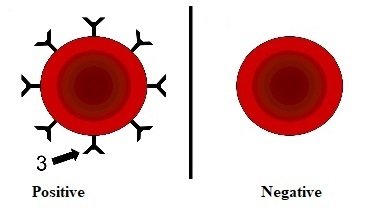
Image credit: Sophiedionne14, CC 4.0 license
One fact that suggests a strong role for genetics in sarcoidosis is its occurrence in family clusters. According to the previously-referenced WSOG article, studies of cluster families show a correlation between blood type and the development of sarcoidosis. The authors suggest a need "to investigate the Rh blood group genotypes as the triggering stimuli for sarcoidosis".
Another study, published July 2019 in the journal Clinical Laboratories,
identifies a genetic mutation that is found infamily clusters.
Researchers note that this mutation is passed on only to affected family
members and not to those free of the disease. The mutation occurred in
genes responsible for activating "metabolic sensor mTOR."

Treatments

The good news is, most people don't require treatment. If treatment is necessary, however, many of the medicines used to treat sarcoidosis are the same ones used to treat autoimmune diseases. This is true, despite the fact that the Foundation for Sarcoidosis Research states: "based on today’s science we do not advocate using the label “autoimmune” to describe sarcoidosis". If the disease does progress, often several doctors from different specialties will collaborate on a plan, because a number of organs may be affected.
Treatment options listed here are derived from information provided by the Foundation for Sarcoidosis Research. This list does not include all possible therapies.

Bark of the Cinchona Tree
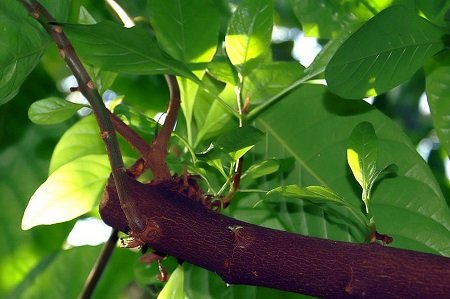
Image credit: David J. Stang CC 4.0 license
Cinchona bark is a source of natural quinine, which has been used since the seventeenth century to treat malaria. During WWII, it was discovered that synthetic forms of anti-malarials, were effective at treating some inflammatory diseases. One of those, Plaquenil, is mentioned below.

Corticosteroids: The first line of defense. Prednisone and Prednisolone are the most common forms administered.
Immune Suppressant Drugs: These include Azathioprine, Methotrexate and Mycophenalate.
Anti-Malarial Drugs: These include Plaquenil and Aralen.

International Resources for Patients and Families

The World Association for Sarcoidosis and other Granulomatous Diseases offers a list of twenty treatment centers in the U. S. here.
The Foundation for Sarcoidosis Research has endorsed treatment centers in different areas of the world. A few of these centers are listed below. Please check the organization's website for a more extensive list, if your country is not included here.
Canada
Mount Sinai Hospital – Toronto, Canada
Germany
Hannover Medical School – Hannover, Germany
Ruhrlandklinik University Hospital – Essen, Germany
Thoraxklinik at Heidelberg University Hospital – Heidelberg, Germany
University Medical Center Goettingen – Göttingen, Germany
Greece
Corfu General Hospital – Corfu, Greece
Hospital for the Diseases of the Chest – Athens, Greece
Netherlands
Catharina Hospital – Noord Brabant, Netherlands
Erasmus University Medical Center – Rotterdam, Netherlands
ETZ Tilburg – Tilburg, Netherlands

Final Word About Vitamin D

Proceed with caution. While people with sarcoidosis may be deficient in Vitamin D, there is a risk of developing hypercalcemia. A couple of articles that address this: Goldilocks, vitamin D and sarcoidosis and Vitamin D Supplementation: Not So Simple in Sarcoidosis.

Conclusion

I know this blog was rather dense, but I wanted to cover the topic responsibly. As I said in a previous blog, information is power. I tried to wade my way through research papers and spread a little power around :))

Selected Sources
A historical sketch; life and time of Jonathan Hutchinson(1828-1913), the first sarcoidologist
Journal of the Royal Society of Medicine Volume74February1981147 The eponymy of sarcoidosis
Yorkshire Philosophical Society, Jonathan Hutchinson
Foundation for Sarcoidosis Research, Causes and Risk Factors
Boston Medical Journal, A clinicopathological classification of granulomatous disorders
Plastic Reconstructive Surgery, Breast implant-related silicone granulomas: the literature and the litigation
Boston Medical Journal, Host-microbe interactions in the pathogenesis and clinical course of sarcoidosis
Veterinary Dermatology, Clinical and histopathological presentation and successful treatment with ciclosporin for canine sarcoidosis: a case report
Boston Medical Journal Risk of sarcoidosis and seropositive rheumatoid arthritis from occupational silica exposure in Swedish iron foundries: a retrospective cohort study
Burning Issues, A Current Assessment of Rurally Linked Exposures as Potential Risk Factors for Sarcoidosis
Boston Medical Journal, Molecular analysis of sarcoidosis lymph nodes for microorganisms: a case–control study with clinical correlates
Environmental Science: Nano, Nano to micron-sized particle detection in patients' lungs and its pathological significance
Current Opinion in Allergy and Clinical Immunology, Occupational Causes of Sarcoidosis
Madison College.edu, Life's Blood
American Journal of Respiratory and Critical Care Medicine Sarcoidosis in America Analysis Based on Health Care Use
Journal of the Royal Society of Medicine, The eponymy of sarcoidosis
Stop Sarcoidosis.org, What Is Sarcoidosis
Mayo Clinic, Granulomas
Veterinary Dermatology, Clinical and histopathological presentation and successful treatment with ciclosporin for canine sarcoidosis: a case report
Science Direst, Foreign Body Reaction
Boston Medical Journal, A clinicopathological classification of granulomatous
Family Doctor, Sarcoidosis
My Cleveland Clinic, Respiratory Sarcoidosis
Worldwide Science, Sarcoidosis
Journal of Biomedical Science Host-microbe interactions in the pathogenesis and clinical course of sarcoidosis
Journal of Clinical Imaging Science, Accuracy of Serial PET-CT Imaging in Systemic Sarcoidosis
University of Rochester Medical Center Angiotensin Converting Enzyme (Blood)
Sarcoidosis News, Transbronchial Lung Cryobiopsy
Journal of Biomedical Science, Host-microbe interactions in the pathogenesis and clinical course of sarcoidosis
NHS. UK, Tuberculosis Causes
Respiratory Medicine,Post-9/11 sarcoidosis in WTC-exposedfirefighters and emergencymedical service workers
Frontiers in Immunology, Silica, Silicosis, and Autoimmunity
Journal of Exposure Analysis and Environmental Epidemiology,The regulation of crystalline silica: an industry perspective
Researchgate,Cat Litter a Possible Trigger for Sarcoidosis
Journal of Exposure Analysis and Environmental The regulation of crystalline silica: an industry perspective Epidemiology
World Association of Sarcoidosis and other Granulomatous Disorders,
Mattioli Journals, Cipro.
Mattioli Journals, Seven Statistically Significant Sarcoidosis Linked Dichotomies
Sarcoidosis News, Sarcoidosis Risk Higher in Families with Disease History
Clinical Laboratories,Researchers Discover Causative Genetic Mutations in Patients with Familial Sarcoidosis
Stop Sarcoidosis.org, What is Sarcoidosis Causes/Risk Factors
Foundation for Sarcoidosis Research, What is Sarcoidosis Treatment Options
Malaria Journal, Quinine, an old anti-malarial drug in a modern world: role in the treatment of malaria
Rheumatologia,Antimalarials – are they effective and safe in rheumatic diseases?
Stop Sarcoidosis.org, Sarcoidosis Clinics
Arthritis Research Therapy,Goldilocks, vitamin D and sarcoidosis
American Journal of Medical Science, Vitamin D Supplementation: Not So Simple in Sarcoidosis


Hi AG! Just stopping by to wish you and yours a Merry Christmas! Hugs!
Thank you, dear @whatisnew. It is a lovely Christmas and I hope you and your family are well, peaceful and happy.
Love, AG
Thanks AG! It was a great Christmas! I spent the day and night at my brother's. His wife (my SIL) is home for good now so that made us all happy. The sad news is that she needs to have another knee surgery on January 15th but we are all going to make sure that nothing like the last time will happen to her ever again.
She must be dreading it. Family is everything now.
She is. She said that this will be her last surgery no matter what. I agree...family is everything.
Researching diseases is terribly confusing unless you have some schooling in the medical field. The way you put this information in laymen terms is remarkable AG. I had to chuckle when I saw that you adapted the diagram to make the model look like it was winking. Only you AG...only you would have thought to do that! I said to myself, "That's my girl!"
Keep spreading the power AG! Hugs!
What a lovely comment. Yeah, those research papers are challenging. I spend so much time looking up terms. But I I think we all have been faced with a medical issue, for our families or ourselves. If we're going to be partners in care--and we must be--then we have to understand options. So I press on.
Thank you for liking my winking diagram. If you saw the original--skeletal!--you'd laugh:)
Hope you are having a relaxing, peaceful season. I'm in holiday mood 🌟 🌟 Hugs to you!
My dearest @agmoore2,
This is just a very quick message to let you know I'm thinking of you and wishing that the new year that will soon begin brings tranquility and prosperity to your home.
All the best my dear friend, who I never met in person but sure lives in my heart! <3
Happy 2020 :D
With infinite affection & respect,
Abigail :)
My dear Abigail,
How happy you make me today. Last night I spoke about you, with a 'real' person, not a virtual friend. Your words and your influence have become part of me. You have been on my mind and in my heart.
Thank you for your kindness, your affection and the example you set--for me, and everyone else.
Looking forward to another year, and more inspiration from you.
With love, respect, and best wishes for you and your family,
Your friend,
AG
<3
Du hasd dicke Eier !!!!!!!!!
Ich habe nicht das Gefühl, als hatten wir uns aus unserer Umarmung nur ein paar Millimeter .......
Oh, dein Schoss ein OMGöttlich behüteter Brunnen ......
This post has been voted on by the SteemSTEM curation team and voting trail. It is elligible for support from @curie and @minnowbooster.
If you appreciate the work we are doing, then consider supporting our witness @stem.witness. Additional witness support to the curie witness would be appreciated as well.
For additional information please join us on the SteemSTEM discord and to get to know the rest of the community!
Thanks for having used the steemstem.io app and included @steemstem in the list of beneficiaries of this post. This granted you a stronger support from SteemSTEM.
Thank you! Really feels great to meet your standards :)
@agmoore2,
Once again your research makes me aware of something I was not familiar with before. It's nice to start the day learning something new. Thank you for this my dear friend :)
I was curious about the actual granulomas: how they can form in various different body tissues (lungs', eyes', skin's), and how they can be harmless or become damaging. I'm guessing that considering that treatment is not always required they mustn't be burdensome (itchy, painful...).
As anyone else, whenever reading about a disease my foremost interest is in its causes, and I must say you never fail to give a balanced account of different internal and external factors.
This leads me to first, comment on the image of the women working in the war factory (I found it touching). And second, on the overall illustration of your article (including the guy winking at us! :D) There are many reasons why your work stick to our minds @agmoore2, and one of them is sure your attention to detail.
You're commitment not only to deliver responsibly written information, but also to provide a pleasant read to your audience.
Beautiful research!
Abigail :D
With love & admiration (always), from sunny, cold Portugal <3
Thank you, dear Abigail for your kind words. Such a long blog...thank you for enduring to the end.
I knew so little about this disease, also. One of my challenges was to inform and not alarm. It's hard to look up stuff on the Internet without getting depressed--I've been there. The little touches you noticed (so happy you did!) were added to help make the blog 'gentle'.
As for how the granulomas can exist without being harmful: I'm sure we've all had a scan where something was noted and the doctor said, "Don't worry, that will probably never give you trouble". It's amazing to me, sometimes, how our bodies chug along, year after year, with all the accumulated insults. Whoever designed this machine had a pretty good plan:)
I'm glad the sun is shining in Portugal. Raining here, and cold. Shopping from a computer terminal is very attractive. If a gift is not available online, I don't think my family will receive it:))
Thank you again for your consistent encouragement and support.
Peace, happiness and health to you and your family, dear Abigail.
Love from across the sea,
AG
😂
Online shopping truly is a saviour!
Thank you for your reply & good wishes my dear friend from across the sea.
May you and all your loved ones have a happy Christmas! <3 :)
💛 💛 💜 💜
@tipu curate 2
Hi Ag,
gonna read this thoroughly tomorrow. Promise!
It's such an interesting theme and worth much more than a quick glance.
In any case, you have gone to a lot of effort - thank you!
Hello @chriddi,
You are very kind, and very generous. Yes, effort, but with joy. I had a goal. Years ago I was a teacher, so being a conduit for information comes naturally to me. Wonderful when effort is appreciated.
Have the most peaceful day!
Warm regards,
AG
Upvoted 👌 (Mana: 0/10 - need recharge?)
Thank you!
Hey @agmoore2,
thank you for this excellent post. Sometimes I see elderly women with irritations in their face which are similar to pictures related to this disease on wikipedia. Horrible!
Stay healthy and have a nice X-mas time.
Best regards
Chapper
Hi Chapper,
So glad it meets your standards. When I write a blog that involves biology, I think of you sometimes. It's a good way to measure if I'm being responsible about research. Nice to know I met the mark!
I hope you are having a peaceful, fulfilling week and that this season brings you joy.
Warm regards,
AG
In german: Du hast dich selbst übertroffen! ;-) meaning that you explored this topic so seeply... more as in your "normal" posts, which are already deeply researched each time! I hope you can get my point ;-) Thank you for your great work! So many sources, so many questions and different views...
I know that you like to research and that you don't stop before you are satisfied... so i hope you had a bit fun while surfing through the internet ;-))))) Once more a big thank you for your time and your power! Big hugs Kadna
My dear Kadna,
I think I can translate that, intuitively. "You've outdone yourself" we say in English, if I am correct.
I had a goal. That gave my research added interest.
If you only knew what a simple woman I am. To be able to share something that might be of use...wow, that really makes my day.
I wish you and your family good health, happiness and peace this season and throughout the year.
By the way, I've been listening to German poems on and off since I read yours. I'm picking up different accents and realizing that some are easier to understand than others. Just like English :))
Love,
Your friend from New York,
AG
Congratulations @agmoore2! You have completed the following achievement on the Steem blockchain and have been rewarded with new badge(s) :
You can view your badges on your Steem Board and compare to others on the Steem Ranking
If you no longer want to receive notifications, reply to this comment with the word
STOPVote for @Steemitboard as a witness to get one more award and increased upvotes!
Thank you!